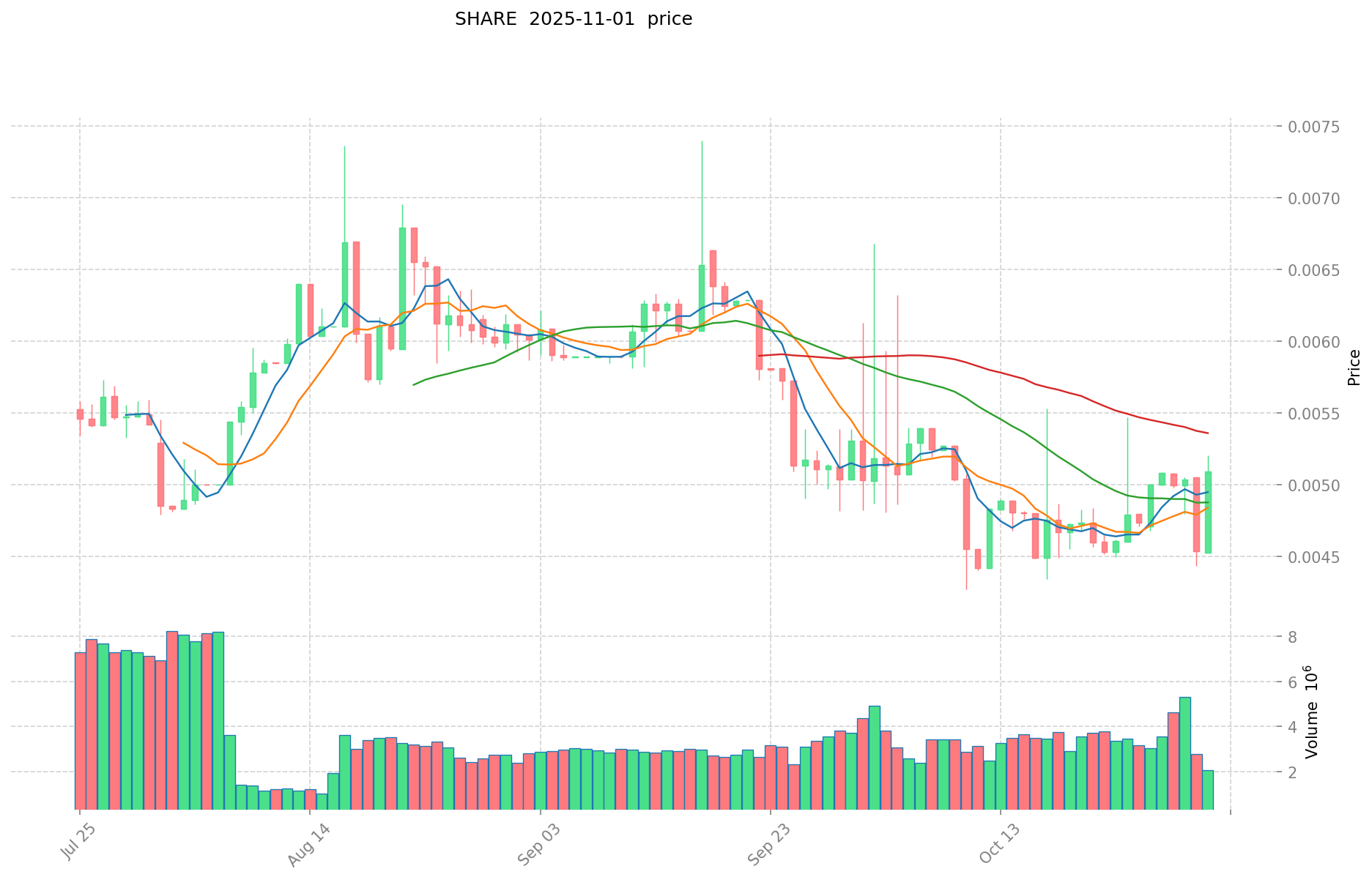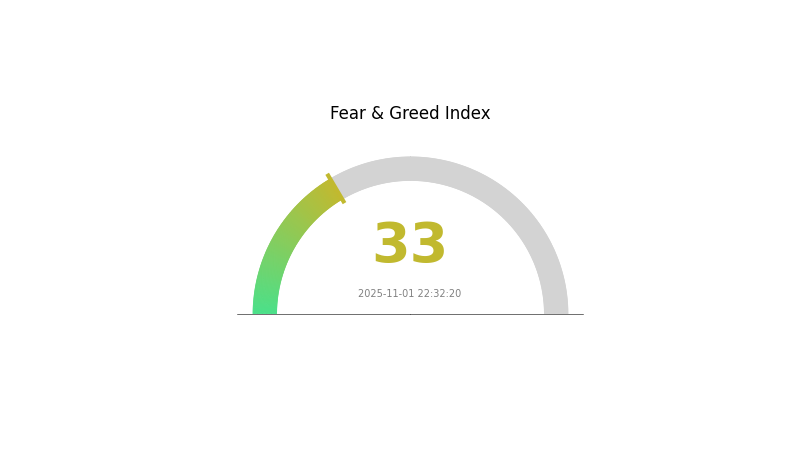2025 SHARE Price Prediction: Analyzing Market Trends and Future Growth Potential
Introduction: SHARE's Market Position and Investment Value
Seigniorage Shares (SHARE), as a governance token in the Dollar Protocol ecosystem, has been playing a crucial role in the decentralized finance (DeFi) space since its inception. As of 2025, SHARE has a market capitalization of $95,756.89, with a circulating supply of approximately 19,403,624.67 tokens, and a price hovering around $0.004935. This asset, often referred to as the "risk investment tool for positive repurchase cycles," is increasingly important in the realm of algorithmic stablecoins and DeFi governance.
This article will provide a comprehensive analysis of SHARE's price trends from 2025 to 2030, taking into account historical patterns, market supply and demand, ecosystem development, and macroeconomic factors, offering professional price predictions and practical investment strategies for investors.
I. SHARE Price History Review and Current Market Status
SHARE Historical Price Evolution
- 2020: SHARE reached its all-time high of $2.95 on September 2, 2020
- 2020: SHARE hit its all-time low of $0.00132146 on November 17, 2020
- 2020-2025: SHARE experienced significant volatility, with price fluctuating between its all-time high and low
SHARE Current Market Situation
As of November 2, 2025, SHARE is trading at $0.004935, with a 24-hour trading volume of $10,468.76. The token has seen a 4.79% increase in the last 24 hours. SHARE's market capitalization currently stands at $95,756.89, ranking it at 5124th position in the cryptocurrency market.
The circulating supply of SHARE is 19,403,624.67 tokens, which represents 92.4% of its total supply of 21,000,000 tokens. Over the past year, SHARE has shown a positive trend with a 20.04% price increase.
Click to view the current SHARE market price

SHARE Market Sentiment Indicator
2025-11-01 Fear and Greed Index: 33 (Fear)
Click to view the current Fear & Greed Index
The crypto market sentiment remains in the "Fear" zone, with the Fear and Greed Index at 33. This indicates a cautious attitude among investors, potentially creating buying opportunities for those with a long-term perspective. However, it's crucial to remember that market sentiment can shift rapidly. Stay informed, manage your risks wisely, and consider dollar-cost averaging as a strategy to navigate through uncertain times. As always, conduct your own research before making any investment decisions.

SHARE Holdings Distribution
The address holdings distribution data for SHARE reveals a highly concentrated ownership structure. The top address holds 25.40% of the total supply, with the second-largest holder controlling 20.10%. Together, the top two addresses account for over 45% of all SHARE tokens. The top five addresses collectively hold 60.28% of the supply, leaving only 39.72% distributed among other holders.
This concentration of holdings raises concerns about market manipulation and volatility. With such a significant portion of tokens in the hands of a few addresses, there's potential for large price swings if these major holders decide to sell or accumulate more tokens. The high concentration also suggests a lower degree of decentralization, which could impact the token's resilience and governance structure.
The current distribution pattern indicates a relatively immature market for SHARE, with potential risks of price manipulation and reduced liquidity. It also suggests that the token's on-chain structure may be less stable, as actions by top holders could significantly influence the overall market dynamics.
Click to view the current SHARE Holdings Distribution

| Top | Address | Holding Qty | Holding (%) |
|---|---|---|---|
| 1 | 0x18f2...2e6cb1 | 5335.11K | 25.40% |
| 2 | 0x0d07...b492fe | 4221.74K | 20.10% |
| 3 | 0x4a76...c1175d | 1596.38K | 7.60% |
| 4 | 0xd6c8...87eaa0 | 763.58K | 3.63% |
| 5 | 0x7e3a...de9145 | 747.39K | 3.55% |
| - | Others | 8335.79K | 39.72% |
II. Key Factors Affecting SHARE's Future Price
Supply Mechanism
- Historical Pattern: Past supply changes have influenced price movements
- Current Impact: Expected impact of the current supply change
Institutional and Major Holder Dynamics
- Institutional Holdings: Current holdings of major institutions
- Corporate Adoption: Well-known companies adopting SHARE
Macroeconomic Environment
- Monetary Policy Impact: Expected policies of major central banks
- Inflation Hedging Properties: Performance in inflationary environments
Technical Development and Ecosystem Building
- Ecosystem Applications: Major DApps/ecosystem projects
III. SHARE Price Prediction for 2025-2030
2025 Outlook
- Conservative forecast: $0.00424 - $0.00494
- Neutral forecast: $0.00494 - $0.00540
- Optimistic forecast: $0.00540 - $0.00587 (requires positive market sentiment)
2027-2028 Outlook
- Market phase expectation: Potential growth phase
- Price range forecast:
- 2027: $0.00525 - $0.00712
- 2028: $0.00415 - $0.00881
- Key catalysts: Increasing adoption and technological advancements
2029-2030 Long-term Outlook
- Base scenario: $0.00760 - $0.00862 (assuming steady market growth)
- Optimistic scenario: $0.00862 - $0.00965 (assuming strong market performance)
- Transformative scenario: $0.00965+ (assuming exceptional market conditions and widespread adoption)
- 2030-12-31: SHARE $0.00905 (potential peak before year-end consolidation)
| 年份 | 预测最高价 | 预测平均价格 | 预测最低价 | 涨跌幅 |
|---|---|---|---|---|
| 2025 | 0.00587 | 0.00494 | 0.00424 | 0 |
| 2026 | 0.00589 | 0.0054 | 0.00497 | 9 |
| 2027 | 0.00712 | 0.00565 | 0.00525 | 14 |
| 2028 | 0.00881 | 0.00638 | 0.00415 | 29 |
| 2029 | 0.00965 | 0.0076 | 0.00524 | 53 |
| 2030 | 0.00905 | 0.00862 | 0.00491 | 74 |
IV. SHARE Professional Investment Strategies and Risk Management
SHARE Investment Methodology
(1) Long-term Holding Strategy
- Suitable for: Risk-tolerant investors with a long-term perspective
- Operational suggestions:
- Accumulate SHARE tokens during market dips
- Participate in governance voting to shape the protocol's future
- Store tokens securely in non-custodial wallets
(2) Active Trading Strategy
- Technical analysis tools:
- Moving Averages: Use to identify trend directions and potential reversals
- Relative Strength Index (RSI): Monitor overbought/oversold conditions
- Key points for swing trading:
- Monitor Dollar Protocol's repurchase cycles
- Keep track of governance proposals that may impact SHARE value
SHARE Risk Management Framework
(1) Asset Allocation Principles
- Conservative investors: 1-3% of crypto portfolio
- Aggressive investors: 5-10% of crypto portfolio
- Professional investors: Up to 15% of crypto portfolio
(2) Risk Hedging Solutions
- Diversification: Balance SHARE holdings with other stablecoins and DeFi assets
- Stop-loss orders: Implement to limit potential losses
(3) Secure Storage Solutions
- Hot wallet recommendation: Gate Web3 Wallet
- Cold storage solution: Hardware wallets for long-term holdings
- Security precautions: Enable two-factor authentication, use strong passwords
V. Potential Risks and Challenges for SHARE
SHARE Market Risks
- High volatility: Price can fluctuate dramatically based on Dollar Protocol performance
- Low liquidity: Limited trading volume may lead to slippage
- Competitive pressure: Other algorithmic stablecoin projects may impact market share
SHARE Regulatory Risks
- Uncertain regulatory landscape: Potential for increased scrutiny of DeFi projects
- Compliance challenges: May face difficulties adapting to new regulations
- Cross-border restrictions: Possible limitations on international usage
SHARE Technical Risks
- Smart contract vulnerabilities: Potential for exploits or bugs in the protocol
- Scalability issues: May face challenges as user base grows
- Governance attacks: Risk of malicious actors manipulating voting processes
VI. Conclusion and Action Recommendations
SHARE Investment Value Assessment
SHARE presents a high-risk, high-reward opportunity within the DeFi space. Long-term value is tied to the success of Dollar Protocol, while short-term risks include volatility and regulatory uncertainty.
SHARE Investment Recommendations
✅ Beginners: Limit exposure, focus on education about algorithmic stablecoins ✅ Experienced investors: Consider small allocations as part of a diversified DeFi portfolio ✅ Institutional investors: Conduct thorough due diligence, potentially engage through governance
SHARE Participation Methods
- Direct purchase: Buy SHARE tokens on Gate.com
- Liquidity provision: Participate in liquidity pools if available
- Governance participation: Stake SHARE tokens to vote on protocol decisions
Cryptocurrency investments carry extremely high risks, and this article does not constitute investment advice. Investors should make decisions carefully based on their own risk tolerance and are advised to consult professional financial advisors. Never invest more than you can afford to lose.
FAQ
Is the stock market expected to go up in 2025?
The stock market may face volatility in 2025 due to global trade uncertainties. Big Tech and AI stocks could outperform, but higher valuations may limit overall market growth.
What is the 7% rule in stocks?
The 7% rule is a stop-loss strategy where traders exit a position if the stock price drops 7% from the purchase price. It helps manage risk and protect capital while allowing profitable trades to grow.
Is the US in a stock bubble?
As of 2025, the US market shows high valuations, but it's not definitively a bubble. Economic indicators are mixed, requiring further analysis.
Why is the share market falling?
The share market is falling due to global trade tensions, economic uncertainty, and investor panic. These factors often lead to sudden drops in stock prices.
Share
Content